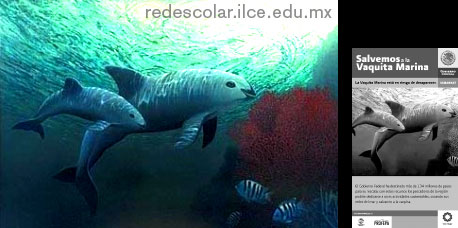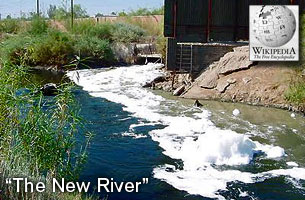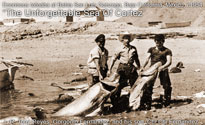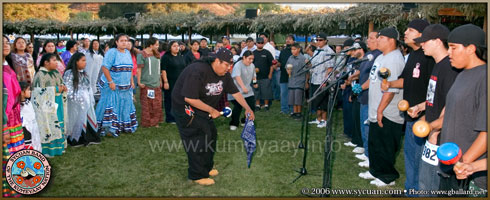Webmaster's note, indigenous peoples water rights:
- The plight of the indigenous Colorado River peoples caught the attention of researcher-activist Ray William Askins, Jr., and he submitted his his forum link to DISCUSS INDIGENOUS WATER RIGHTS ISSUES (URL broken). This page was inspired by Mr. Askins and includes excerpts of his letter to Congressman Bob Filner, Report 33, that he submitted to the Cocopah documentary for publication.
INDIGENOUS TRIBAL FISHING VILLAGE
Pre-contact Eden to present-day ecological disaster

EL MAYOR, CUCAPA INDIAN VILLAGE, BAJA CALIF, MEXICO:
The Cocopah Indians -- an indigenous Colorado River tribe -- have occupied El Mayor fishing village on the Rio Hardy and fished its rich tribal waters for thousands of years.
These indigenous tribal lands and surrounding sacred Cocopah Indian mountains comprise the heart of the Colorado Delta Region and slowly drain what's left of the Colorado River water into once was the largest and historically the richest natural estuary in the world: The upper Gulf of California, the Sea of Cortez.
At the turn of the 21st Century, however, this area has become a modern ECOLOGICAL DISASTER by any world standard, and its Indigenous river peoples are victims of industrial and farm pollution, over fishing, people taking too much water up stream, and traces of uranium found Native American lands via commercial mining polution on the mighty Colorado waterway.
- EIGHTY YEARS AGO when traveler Aldo Leopold visited this pristine tribal area in 1922, he wrote of "awesome jungles ... lovely groves ... still waters of a deep emerald hue." Aldo described it an Eden alive with colorful birds of every size, deer, bobcats and coyotes.
"The river was everywhere and nowhere, for (it) could not decide which of a hundred green lagoons offered the most pleasant and least speedy path to the gulf."
In 2001, an Associated Press AP journalist visited El Mayor and described it in a national news article as "flyblown and forgotten...".
The journalist added, "the 45 remaining families coax murky water for washing from a distant borehole, but for drinking or cooking they wait for trucks that sell clean water at seven pesos (65 cents) for a five-gallon jug....".
THE NEW RIVER
A Present-Day Ecological Disaster
The NEW RIVER flows north from the city of Mexicali, Baja California, Mexico into the United States through the city of Calexico, California. The river has been referred to as the most severely polluted river of its size within the United States...The New River at the International Boundary, is pictured above carrying foam and mixing with wastewater from the International Drain.
- THE NEW RIVER’s flow is composed of waste from agricultural and chemical runoff from farm industry irrigation in the U.S. (18.4%) and Mexico (51.2%), sewage from Mexicali (29%), and manufacturing plants operating in Mexico (1.4%).
By the time the New River crosses the U.S./Mexico border near Calexico, California, the channel contains a stew of about 100 contaminants: Volatile organic compounds, heavy metals, including selenium, uranium, arsenic and mercury, and pesticides, DDT and PCBs.
WATER QUALITY OF RIO HARDY
By comparison the same is happening to the RIO HARDY.
The Hardy River has become a drain for agricultural waters polluted with pesticides and fertilizers from the Mexicali Valley. The water quality in the River Hardy is being monitored at Mexicali by the Centro de Investigacion en Alimentacion y Desarrollo A.C. to measure the effects of discharge on the waterway from the Las Arenitas wastewater treatment plant...
|
1950s HISTORICAL FISHING
|
MODERN POLLUTION
OVER FISHING
SEVERELY DECREASED WATER FLOW
Depending on who you talk to, the problems down river in the Colorado River Delta and Gulf of California, Sea of Cortez, are caused by POLLUTION, OVER FISHING and/or the small AMOUNT OF WATER the United States lets flow past the US-Mexico border.
In any case, ecologists and scientists have documented catastrophic environmental damage to a once-thriving shrimp industry and important fish-breeding grounds in the upper Gulf of California. Both fisheries are dependent on the estuary's natural mix of clean fresh delta water and salty gulf seawater to sustain their life....
|
COLORADO RIVER MAY FACE FIGHT OF ITS LIFE Increased toxins likely as energy companies seek oil, gas, uranium THE SANDIEGO UNION-TRIBUBE story by Abrahm Lustgarten (PROPUBLICA) and David Hasemyer (U-T STAFF WRITER), December 21, 2008:
|
MEXICAN GOVERNMENT Conservation Zones

El rescate de la vaquita marina, redescolar.ilce.edu.mx
Efforts by the Mexican government to create conservation zones zones have been hampered by lack of enforcement resources as well as a lack of a political consensus on this issues of conservation of the Gulf of California and Colorado River Delta.
U.S. GOVERNMENT
The United States Environmental Protection Agency (EPA) and Colorado River Basin Regional Water Quality Control Board are tasked with responsibility.
|
INDIGENOUS YUMAN TRIBAL PEOPLES
The Cucapa Native Americans belong to the YUMAN INDIAN FAMILY GROUP OF THE HOKAN LANGUAGE FAMILY — it is this family of indigenous tribal peoples who suffer the brunt of the problem in the Delta Region. Pictured above, Yuman Indian family of indigenous tribal peoples of California, including Indians of the Colorado River Delta Region, are pictured above at a traditional gathering on the Sycuan Indian Reservation in 2006 may include tribal singers and dancers of the Quechan, Cocopah Cucapa, Kumeyaay Kumiai, Mohave, Paipai Pai Pai, Ipai Tipai, Kiliwa, Hualapai, Yavapai, Havasupai, Maricopa, and Cahuilla Indian nations. |
Kumeyaay Indians Home • About Us • Mission Statement • Press Kit • Contact Us


